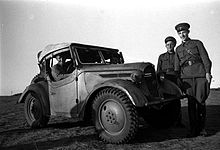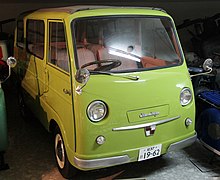Tōkyū Kurogane Kōgyō
| Nihon Jidōsha (1928–1936) Nihon Nainenki Seizō (1936–1957) Nihon Jidōsha Kōgyō (1957–1959) Tōkyū Kurogane Kōgyō (1959–1962) |
|
|---|---|
| legal form | Kabushiki-gaisha (joint stock company) |
| founding | 1928 |
| resolution | 1962 |
| Seat | Tokyo , Japan |
| Branch | Motor vehicles |
Tōkyū Kurogane Kōgyō KK ( Japanese 東 急 く ろ が ね 工業 株式会社 ), previously Nihon Jidōsha KK ( 日本 自動 車 株式会社 , also Nippon Jidōsha ), Nihon Nainenki Seizō KK ( 日本 内燃機 製造 株式会社 , English Nippon Internal Ltd. ) Combustion Engine Company Ltd. and Nihon Jidōsha Kōgyō KK ( 日本 自動 車 工業 株式会社 , English Nippon Motor Industry ), was a manufacturer of motor vehicles from Japan .
Company history
The company Nippon Jidōsha from Ōmori started producing motor vehicles in 1928. The brand name was initially New Era . In 1936 the name was changed to Nihon Nainenki Seizō KK. From 1937 the brand name was Kurogane ( く ろ が ね ). However, prototypes were given this name as early as 1935 and 1936 . At the time there were other plants in Amagasaki , Kamata , Kawasaki and Samukawa .
After the war, the Kamata plant was temporarily leased to Toyota . 1957 Ōta Jidōsha Kōgyō was taken over and the company name changed to Nihon Jidōsha Kōgyō KK . Other sources name only one company name for the period from 1935 to 1959, either Nippon Nainenki Seizo or Nippon Jidōsha . In 1959 the last name was changed to Tōkyū Kurogane Kōgyō or, incorrectly, Tokyo Kurogane Kogyo .
Production ended in 1962.
vehicles
Initially, three-wheeled commercial vehicles with a single front wheel were created.
The Type 95 reconnaissance vehicle was added in 1937 . This was preceded by a prototype as a two-door sedan as the Type 95 Model 1 in 1935 and a roadster as the Type 95 Model 2 in 1936 . This small four-wheel drive car was designed for the military. Initially it offered two seats, later three seats. Of these, around 3000 vehicles or around 4800 vehicles were built.
From 1949 the company mainly produced commercial vehicles with three and four wheels. Among them was the Baby model with an air-cooled two - cylinder four-stroke engine with a capacity of 356 cm³ and 18 hp in the rear.
literature
- Harald H. Linz, Halwart Schrader : The International Automobile Encyclopedia . United Soft Media Verlag, Munich 2008, ISBN 978-3-8032-9876-8 , chapter Kurogane.
- George Nicholas Georgano (Ed.): The Beaulieu Encyclopedia of the Automobile . Volume 2: G-O . Fitzroy Dearborn Publishers, Chicago 2001, ISBN 1-57958-293-1 , pp. 839 (English).
- Jan P. Norbye: Cars made in Japan. Corporations · Data · Facts. All makes and models 1912–1992. Bleicher Verlag, Gerlingen 1991, ISBN 3-88350-161-1 , p. 61, p. 74 and p. 89.
Web links
- 3wheelers.com (English)
- d'Auto (Dutch)
- Allcarindex (English)
Individual evidence
- ↑ a b c d e Harald H. Linz, Halwart Schrader : The International Automobile Encyclopedia . United Soft Media Verlag, Munich 2008, ISBN 978-3-8032-9876-8 , chapter Kurogane.
- ↑ a b c d e f George Nicholas Georgano (Ed.): The Beaulieu Encyclopedia of the Automobile . Volume 2: G-O . Fitzroy Dearborn Publishers, Chicago 2001, ISBN 1-57958-293-1 , pp. 839 (English).
- ↑ a b c d e f g Jan P. Norbye: Cars made in Japan. Corporations · Data · Facts. All makes and models 1912–1992. Bleicher Verlag, Gerlingen 1991, ISBN 3-88350-161-1 , p. 61, p. 74 and p. 89.
- ↑ Jeremy Risdon: Pomchi Book of Cars, Vans & Light Trucks. Volume 2. Japan 1935-1939 . Pomchi Press, Yate 2017, ISBN 978-1-983476-36-5 , pp. 54-60 (English).
- ↑ 75 Years of TOYOTA - Part 1, Chapter 2, Section 6 - Item 6. Closure of Shibaura and Kamata Plants. In: toyota-global.com. August 1, 2016, accessed March 3, 2019 .
- ↑ Marián Šuman-Hreblay: Automobile Manufacturers Worldwide Registry. McFarland & Company, Inc., Publishers, London 2000, ISBN 0-7864-0972-X , p. 168. (English)


